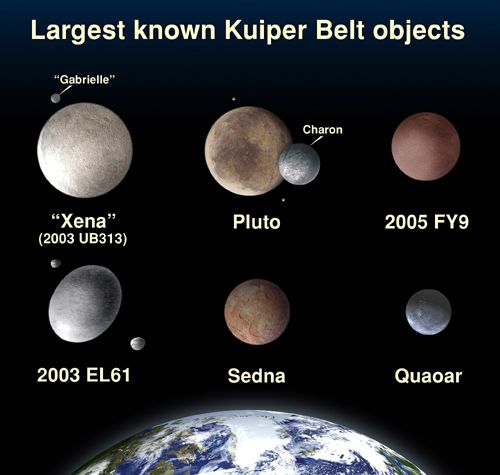July, 2015
Pursuing Pluto
When the NASA New Horizon's space mission to Pluto began, on 1/19/2006, that orb was considered our Solar System's ninth planet, yet by the time the Pluto-bound craft arrived and in the last several days began sending back magnificent pictures, Pluto's status had been denigrated to just one of 40 currently known dwarf planets orbiting our sun. Even this designation is controversial, many scientists believing Pluto is but one of thousands of planetesimals. Zooming to within 7800 miles of Pluto's surface by 7/14/15, New Horizons took sharp, detailed pictures and collected much other info. Pluto's decertification as an official planet hardly has dampened enthusiasm for the mission results so far. 
Largest known Kuiper Belt objects (NASA) |
- The discovery of up to 11,000 foot high ice mountains on Pluto's surface, suggesting the sphere is still geologically active;
- Vivid images of Pluto's largest moon, Charon, show its surface surprisingly lacking in craters, so this little world may remain active as well;
- There are dark patches in a polar region of Charon, felt to be hydrocarbons.
- Rocks on Pluto are of at least two kinds: intensely frozen water and methane.
- The spacecraft is operating beautifully, collecting vast amounts of data plus images on Pluto and its moons that are being sent back to Earth gradually, so all of it is not expected to have been transmitted till sixteen months from now.
- While New Horizons continues to sedately beam back data already obtained, its sensors are capturing much more as the mission continues farther into the Kuiper Belt, a vast region of the outer Solar System that lies between the eight orbiting planets and the much larger Oort cloud region. The Kuiper Belt includes icy dwarf planets, planetesimals, and some comets.
What is next for New Horizons? First, the mission has several more weeks of image and data collection slated for the Pluto vicinity. Then, given that onboard power can potentially allow the craft to keep gathering and sending back info up till about 2030, it is hoped that New Horizons will be operational at least well into the Kuiper Belt, perhaps even performing a close-up fly-by of a another dwarf planet. Meanwhile it will be providing much new information on the nature of that region of space. Toward the end of its projected functional life, New Horizons will be over nine billion miles from Earth and, like the earlier Voyager craft, exploring to our Solar system's very limits. Unlike Voyager, however, New Horizons carries much improved modern instruments.
|
